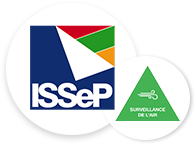Fact file
Aldehydes are a category of gases belonging to the family of volatile organic compounds (VOCs). The two aldehydes most commonly found in the atmosphere are formaldehyde and acetaldehyde. Formaldehyde (also known as methanal or formaldehyde or formol), with the empirical formula HCHO, is the simplest of the aldehydes.
Origin of pollution
In ambient air, the main anthropogenic sources of formaldehyde include direct industrial emissions (manufacture of resins, use of disinfectants and fixatives, or preservatives) and fuel combustion by traffic, as well as to a lesser extent the residential and tertiary sectors (heating).
It should also be noted that secondary formation of formaldehyde occurs in the air through the oxidation of volatile organic compounds (VOCs) and reactions with ozone.
Formaldehyde is one of the most common and most widely incriminated chemical compounds in the indoor environment of buildings. It is emitted during the use or storage of many commonly used products: furniture and decorative materials, coatings and glues, cleaning and disinfecting products, air fresheners and home fragrances, cosmetics, personal hygiene products, etc. It is a constituent of 5% of all chemical products.
Formaldehyde is also emitted during any combustion process (fires, cigarette smoke) and during human activities ( cooking, burning wood).
Health effects
At room temperature, formaldehyde is a colourless gas with an irritating odour.
Aldehydes are toxic to human health. Exposure to formaldehyde can have a number of health effects, depending on the concentration, duration of exposure and sensitivity of the people exposed. It can cause irritation and eyes, respiratory tract and skin inflammation. It can also have harmful effects on the nervous system (increased fatigue, migraines, nausea, dizziness, etc.). Since 2004, formaldehyde has been classified by the International Agency for Research on Cancer (IARC) as a "known human carcinogen".
Environmental impact
Aldehydes have an indirect effect on the environment, since they are ozone precursors that disrupt photosynthesis, with a negative impact on vegetation.
The situation in Wallonia
Formaldehyde is not monitored in the Walloon ambient air quality network, but it is measured at eight stations installed to monitor air quality in the vicinity of Walloon airports.
Formaldehyde levels measured in ambient air are generally low.
There is no legal limit value for formaldehyde in ambient air. AwAC and ULiège have defined an intervention criterion of 8.5 µg/m³ on the basis of toxicological studies.
Measurement methods
Formaldehyde is sampled using a passive radial diffusion sampler (Radiello) over a 2-week period.
Once the cartridge has been taken back to the laboratory, it is eluted with acetonitrile. Formaldehyde is measured using high-performance liquid chromatography/mass spectrometry (HPLC/MS).







